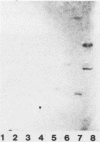Abstract
The binding of Pseudomonas aeruginosa to glycosphingolipids and to buccal and bronchial epithelial cells was analyzed. Three independently expressed specificities were found by bacterial binding to glycosphingolipids separated by thin-layer chromatography. All strains bound gangliotria- and gangliotetrasylceramide. All but one of the strains bound sialic acid-containing glycosphingolipids and lactosylceramide. The latter two specificities could be separated in that the lactosylceramide binding was retained and the sialic acid binding was suppressed when bovine serum albumin was used as a blocking agent in the thin-layer chromatography assay. The attachment to buccal epithelial cells, like the binding to sialylated compounds and lactosylceramide, was abolished by Formalin treatment of the bacteria, suggesting the importance of these specificities for cell adherence. In contrast, the binding to gangliotria- and gangliotetraosylceramide was retained by nonattaching Formalin-treated bacteria.
Full text
PDF
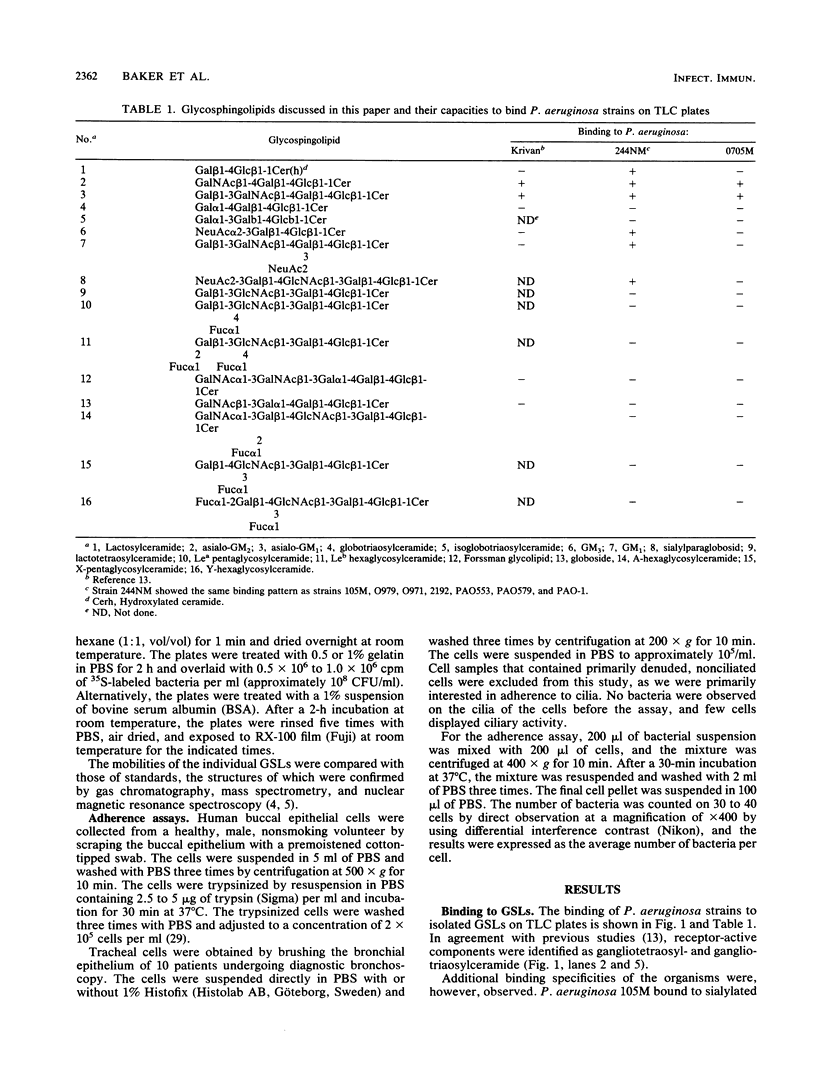
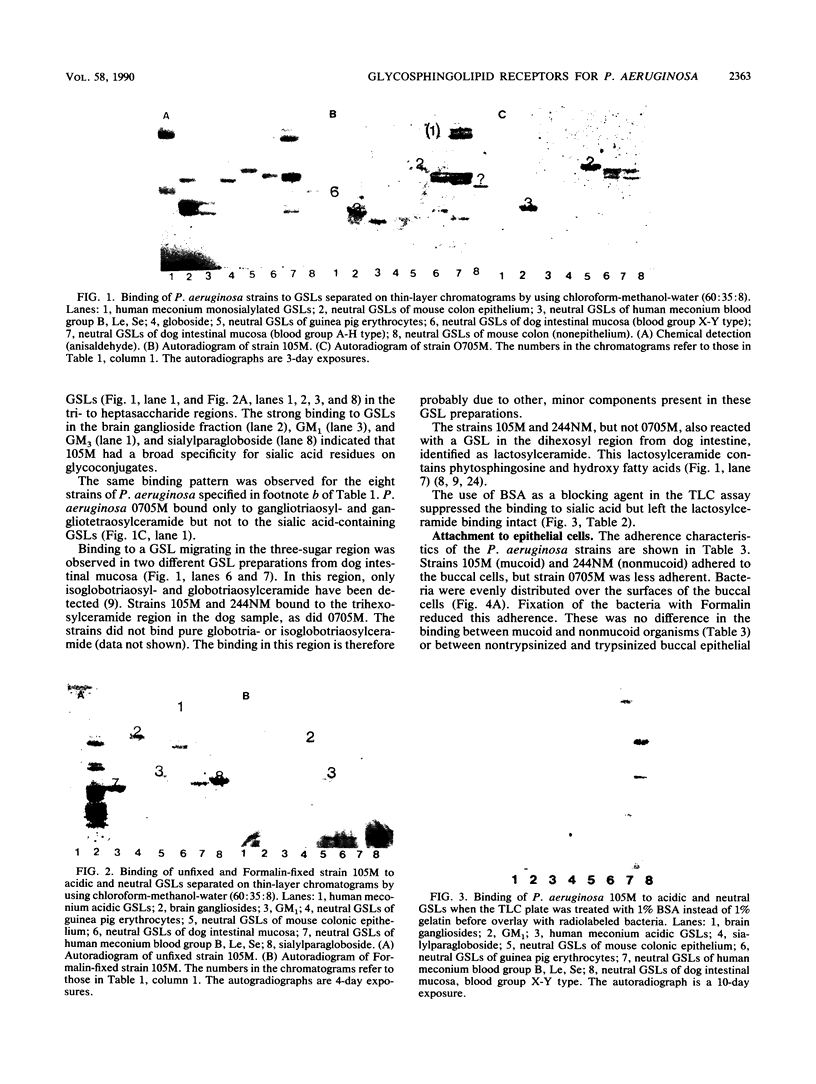
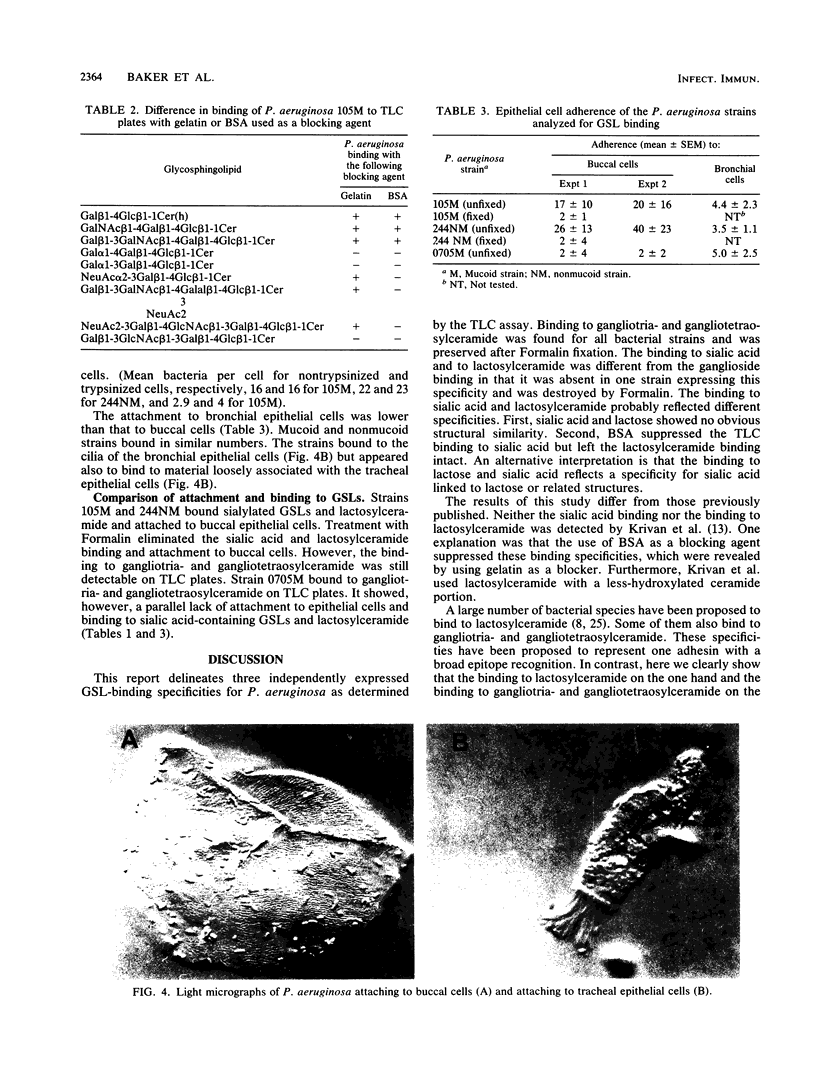
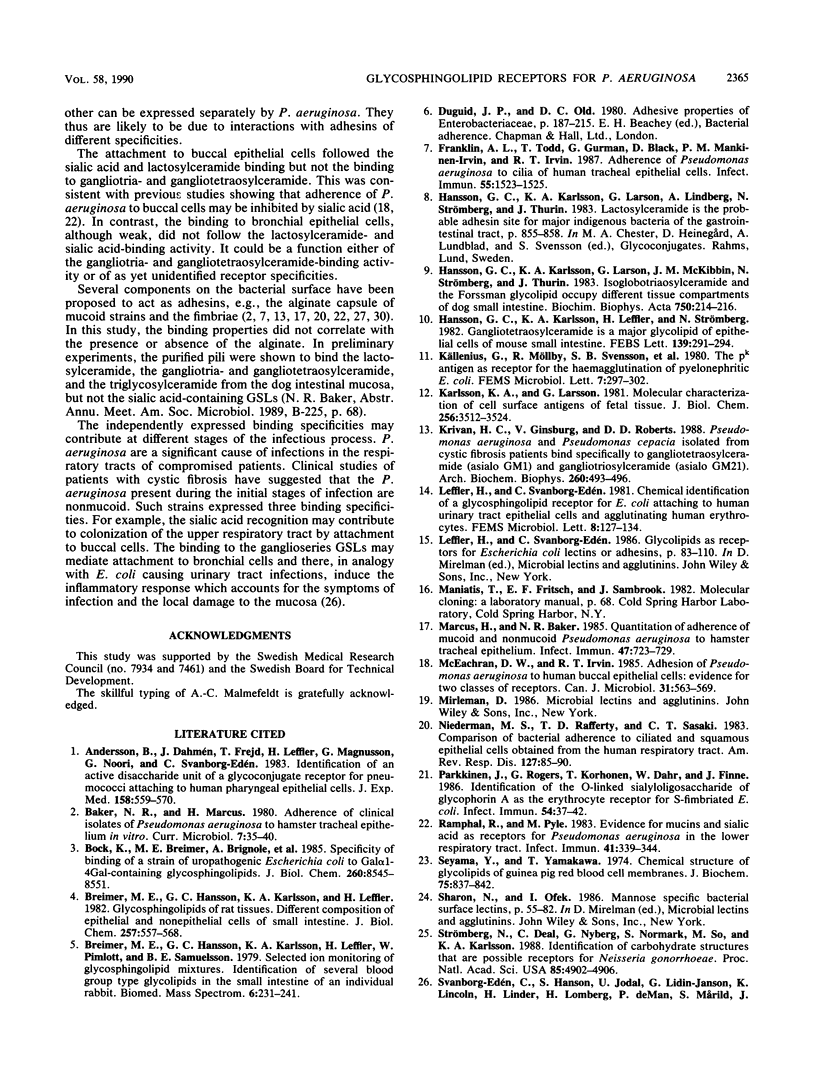
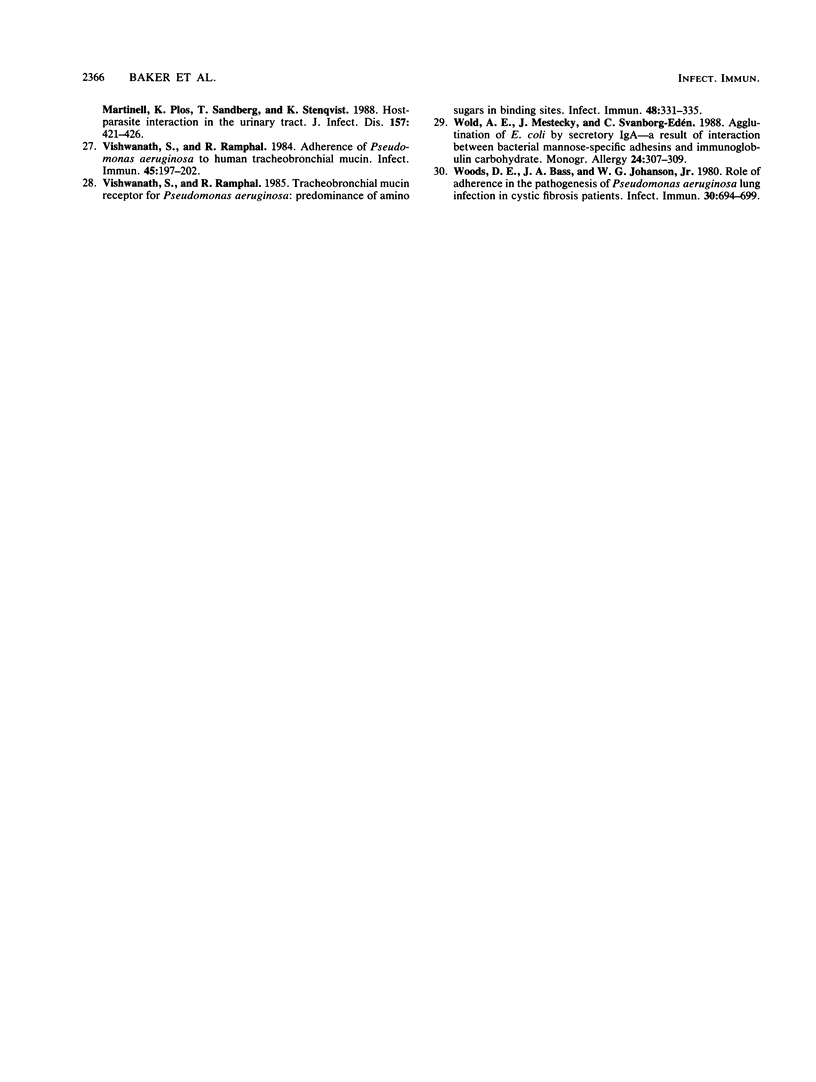
Images in this article
Selected References
These references are in PubMed. This may not be the complete list of references from this article.
- Andersson B., Dahmén J., Frejd T., Leffler H., Magnusson G., Noori G., Edén C. S. Identification of an active disaccharide unit of a glycoconjugate receptor for pneumococci attaching to human pharyngeal epithelial cells. J Exp Med. 1983 Aug 1;158(2):559–570. doi: 10.1084/jem.158.2.559. [DOI] [PMC free article] [PubMed] [Google Scholar]
- Bock K., Breimer M. E., Brignole A., Hansson G. C., Karlsson K. A., Larson G., Leffler H., Samuelsson B. E., Strömberg N., Edén C. S. Specificity of binding of a strain of uropathogenic Escherichia coli to Gal alpha 1----4Gal-containing glycosphingolipids. J Biol Chem. 1985 Jul 15;260(14):8545–8551. [PubMed] [Google Scholar]
- Breimer M. E., Hansson G. C., Karlsson K. A., Leffler H. Glycosphingolipids of rat tissues. Different composition of epithelial and nonepithelial cells of small intestine. J Biol Chem. 1982 Jan 10;257(1):557–568. [PubMed] [Google Scholar]
- Breimer M. E., Hansson G. C., Karlsson K. A., Leffler H., Pimlott W., Samuelsson B. E. Selected ion monitoring of glycospingolipid mixtures. Identification of several blood group type glycolipids in the small intestine of an individual rabbit. Biomed Mass Spectrom. 1979 Jun;6(6):231–241. doi: 10.1002/bms.1200060603. [DOI] [PubMed] [Google Scholar]
- Franklin A. L., Todd T., Gurman G., Black D., Mankinen-Irvin P. M., Irvin R. T. Adherence of Pseudomonas aeruginosa to cilia of human tracheal epithelial cells. Infect Immun. 1987 Jun;55(6):1523–1525. doi: 10.1128/iai.55.6.1523-1525.1987. [DOI] [PMC free article] [PubMed] [Google Scholar]
- Hansson G. C., Karlsson K. A., Larson G., McKibbin J. M., Strömberg N., Thurin J. Isoglobotriaosylceramide and the Forssman glycolipid of dog small intestine occupy separate tissue compartments and differ in ceramide composition. Biochim Biophys Acta. 1983 Jan 7;750(1):214–216. doi: 10.1016/0005-2760(83)90224-2. [DOI] [PubMed] [Google Scholar]
- Hansson G. C., Karlsson K. A., Leffler H., Strömberg N. Gangliotetraosylceramide is a major glycolipid of epithelial cells of mouse small intestine. FEBS Lett. 1982 Mar 22;139(2):291–294. doi: 10.1016/0014-5793(82)80873-9. [DOI] [PubMed] [Google Scholar]
- Karlsson K. A., Larson G. Molecular characterization of cell surface antigens of fetal tissue. Detailed analysis of glycosphingolipids of meconium of a human O Le(a--b+) secretor. J Biol Chem. 1981 Apr 10;256(7):3512–3524. [PubMed] [Google Scholar]
- Krivan H. C., Ginsburg V., Roberts D. D. Pseudomonas aeruginosa and Pseudomonas cepacia isolated from cystic fibrosis patients bind specifically to gangliotetraosylceramide (asialo GM1) and gangliotriaosylceramide (asialo GM2). Arch Biochem Biophys. 1988 Jan;260(1):493–496. doi: 10.1016/0003-9861(88)90473-0. [DOI] [PubMed] [Google Scholar]
- Marcus H., Baker N. R. Quantitation of adherence of mucoid and nonmucoid Pseudomonas aeruginosa to hamster tracheal epithelium. Infect Immun. 1985 Mar;47(3):723–729. doi: 10.1128/iai.47.3.723-729.1985. [DOI] [PMC free article] [PubMed] [Google Scholar]
- McEachran D. W., Irvin R. T. Adhesion of Pseudomonas aeruginosa to human buccal epithelial cells: evidence for two classes of receptors. Can J Microbiol. 1985 Jun;31(6):563–569. doi: 10.1139/m85-105. [DOI] [PubMed] [Google Scholar]
- Niederman M. S., Rafferty T. D., Sasaki C. T., Merrill W. W., Matthay R. A., Reynolds H. Y. Comparison of bacterial adherence to ciliated and squamous epithelial cells obtained from the human respiratory tract. Am Rev Respir Dis. 1983 Jan;127(1):85–90. doi: 10.1164/arrd.1983.127.1.85. [DOI] [PubMed] [Google Scholar]
- Parkkinen J., Rogers G. N., Korhonen T., Dahr W., Finne J. Identification of the O-linked sialyloligosaccharides of glycophorin A as the erythrocyte receptors for S-fimbriated Escherichia coli. Infect Immun. 1986 Oct;54(1):37–42. doi: 10.1128/iai.54.1.37-42.1986. [DOI] [PMC free article] [PubMed] [Google Scholar]
- Ramphal R., Pyle M. Evidence for mucins and sialic acid as receptors for Pseudomonas aeruginosa in the lower respiratory tract. Infect Immun. 1983 Jul;41(1):339–344. doi: 10.1128/iai.41.1.339-344.1983. [DOI] [PMC free article] [PubMed] [Google Scholar]
- Seyama Y., Yamakawa T. Chemical structure of glycolipid of guinea pig red blood cell membrane. J Biochem. 1974 Apr;75(4):837–842. doi: 10.1093/oxfordjournals.jbchem.a130455. [DOI] [PubMed] [Google Scholar]
- Stromberg N., Deal C., Nyberg G., Normark S., So M., Karlsson K. A. Identification of carbohydrate structures that are possible receptors for Neisseria gonorrhoeae. Proc Natl Acad Sci U S A. 1988 Jul;85(13):4902–4906. doi: 10.1073/pnas.85.13.4902. [DOI] [PMC free article] [PubMed] [Google Scholar]
- Svanborg Edén C., Hausson S., Jodal U., Lidin-Janson G., Lincoln K., Linder H., Lomberg H., de Man P., Mårild S., Martinell J. Host-parasite interaction in the urinary tract. J Infect Dis. 1988 Mar;157(3):421–426. doi: 10.1093/infdis/157.3.421. [DOI] [PubMed] [Google Scholar]
- Vishwanath S., Ramphal R. Adherence of Pseudomonas aeruginosa to human tracheobronchial mucin. Infect Immun. 1984 Jul;45(1):197–202. doi: 10.1128/iai.45.1.197-202.1984. [DOI] [PMC free article] [PubMed] [Google Scholar]
- Vishwanath S., Ramphal R. Tracheobronchial mucin receptor for Pseudomonas aeruginosa: predominance of amino sugars in binding sites. Infect Immun. 1985 May;48(2):331–335. doi: 10.1128/iai.48.2.331-335.1985. [DOI] [PMC free article] [PubMed] [Google Scholar]
- Wold A. E., Mestecky J., Svanborg Edén C. Agglutination of E. coli by secretory IgA--a result of interaction between bacterial mannose-specific adhesins and immunoglobulin carbohydrate? Monogr Allergy. 1988;24:307–309. [PubMed] [Google Scholar]
- Woods D. E., Bass J. A., Johanson W. G., Jr, Straus D. C. Role of adherence in the pathogenesis of Pseudomonas aeruginosa lung infection in cystic fibrosis patients. Infect Immun. 1980 Dec;30(3):694–699. doi: 10.1128/iai.30.3.694-699.1980. [DOI] [PMC free article] [PubMed] [Google Scholar]




